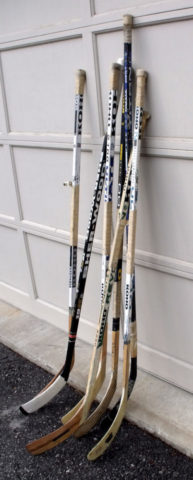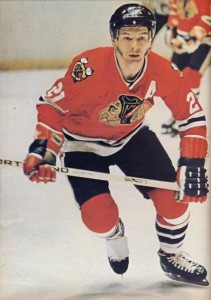The Stick: A history, a celebration, an elegy By Bruce Dowbiggin. (2001, Toronto: Macfarlane, Walter & Ross. Hardcover. Pp. 272. $32.99. ISBN 978-1-5519-9100-9)
This isn’t just a misty-eyed look at your dad’s dusty old straight-blade Sher-Wood

The hockey stick. There’s few pieces of sports equipment like it. Like a baseball player’s glove, it’s a tool of the trade – personal, designed and modified through experience to best exploit the player’s natural skills and abilities. For the best, it’s more… an extension of the player himself, almost a natural part of his body.
Bruce Dowbiggin delves into the origins of one of the most recognizable and sometimes overlooked tools of the hockey trade. From the early Mi’kmaq sticks, created from tree roots and trunks of hard Ash and Yellow Birch to the early 21st century, Dowbiggin traces the history, development and real experiences of the pros to explain the Stick.
A History
Overall, this is a dimensionally small book and a fairly quick read, but don’t mistake this for a purely sentimental remembrance of your dad’s dusty old straight-blade Sher-Wood PMP. Dowbiggin lays out the chronological story of the hockey stick, the progression in manufacturing methods, mixed in with some background into the economic and cultural realities of the last century in Canada. The science and art of selecting the right wood and creating the stick is recollected by those who did the job in the old days.

But Dowbiggin doesn’t stop there. To understand the hockey stick is to know more than simply its origins. There are stories of kids like a young Howie Meeker collecting up the discards from the stick factory to play with, the process of how the modern goalie stick came to be, interviews and anecdotes from players concerning who invented the curved blade (or did they?), and the transition from ash to other wooden sticks and later laminates, aluminum and now graphite.
Dowbiggin does indeed present a celebration of the stick, and yet does not shy away from the truth that the stick, an essential tool of hockey, also has a reputation as a weapon – evidence by Marty McSorley’s swing at Donald Brashear, an act that rocked the hockey world.
The Business
The ritual of players learning to select the type of stick they want, break it in, care for and repair it over the season, and eventually tweak them to give a competitive advantage is found here. Further, Dowbiggin talks to a number of players, both retired and (at the time) active – players such as Al MacInnis, Yvan Cournoyer, Kent Douglas and Adam Oates – to gain insight as to how and why they choose the sticks they use to earn a living.
We learn how one iconic pose from the 1970s led stick companies to realize the marketing value their products had. Hockey sticks have become part of the endorsement and marketing side of the game, even to the point where Wayne Gretzky gave up his red Titan 4020 for an aluminum Easton (a watershed moment for many young hockey players of the era).
The Author
Over almost 30 years, Dowbiggin has covered sports for the CBC, Calgary Herald and the Globe and Mail. The Stick is only one of a number of books he has written covering the sport of hockey. He has previously covered subjects including how hockey and Canada are intrinsically linked; an exploration of the NHL Pension Fund scandal under Alan Eagleson; profiles of leadership in hockey; and more.
The Stick: A history, a celebration, an elegy may have been published over 10 years ago, but it provides insight, perspective and understanding for an often overlooked yet crucial piece of the game.